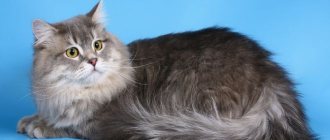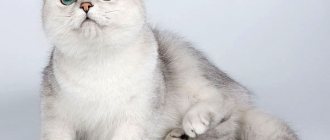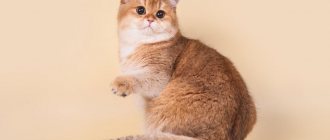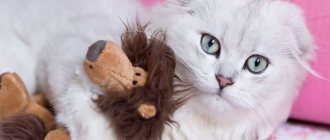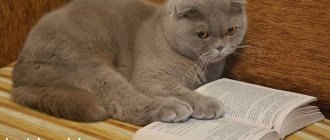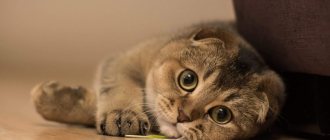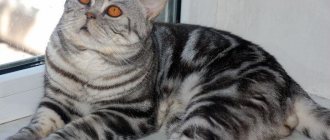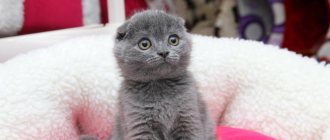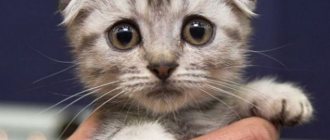The Scottish longhaired straight-eared cat Highland Straight (translation from English from the word “highland”) is a type of Scottish cat breed, the features of which are erect ears and long hair. The advantages of the fluffy Scottish straight-eared cat breed are the same as those of other Scots: good character, calm disposition, sweet appearance, fairly simple maintenance. Highland straights are absolutely stunning creatures, very beautiful, simply fabulous. Unfortunately, the popularity of these cats is still lower than they deserve.
Article continues after advertisement Highland Straight cats: photos
History of the breed
This breed has a long and very interesting history, which begins in the eighteenth century. Scottish cats originate from a wild cat that lived in the mountains. In the process of working on the breed, breeders infused the blood of wild animals into domestic cats, with the goal of obtaining a bright and strong livestock. At different stages of selection, to improve the quality of wool and expand the range of colors, the blood of the British and Persians was infused into Scottish cats.
The unusual, curved shape of the ears became an exclusive feature of the Scottish breed, giving the cats a special charm. The Scots immediately attracted attention and became in demand; The first mentions of them appeared more than two hundred years ago. But within the breed there are not only fold-eared individuals (folds), but also cats with ordinary, straight ears (straights), which in no way reduces the merits of these animals or the interest in them.
Folds and straights are siblings
A variety of Scots with straight ears and a very beautiful coat, soft and flowing, is separated into a separate breed, which is called the Highland Straight and still remains quite rare. This is a fairly young breed that received official recognition only in 1970.
Description of Highland Straight cats
The Scottish breed includes four varieties of cats. Scots can be either shorthaired or semi-longhaired; both short-eared and straight-eared . They all have the same breed requirements and characteristics - the only difference is in the shape and placement of the ears. You can see some similarities between the straight-eared Scots and the British, but upon closer examination it becomes clear: these are completely different breeds, differing in many ways both in appearance and in behavioral characteristics.
Highland Straight - an aristocrat of the cat world
However, even within the large and popular Scottish breed, Highland Straights stand somewhat apart - these are very interesting cats, and it is no coincidence that the owners of this breed become its ardent fans forever.
Their noble Scottish origin is felt in everything - from the nuances of appearance to every movement. Highland straights are unusually elegant and aristocratic, but at the same time they are not snobs or arrogant at all, but very nice, good-natured and sociable guys.
External data
Cats of this breed have medium dimensions: the weight of an adult individual reaches six kilograms, and the height is thirty centimeters at the withers. The body is strong, strong, with wide bones and a pronounced topline. The tail is quite long, fluffy and flexible - if desired, you can easily wrap it in several rings around your finger, and the cat will not experience any discomfort from this. The head is round, the ears are small, erect, slightly rounded at the top - they should be evenly covered with hair of the same length.
Highland Straight is a strong and harmonious cat
A huge number of colors are allowed in the breed, but according to the standard, the color of the animal’s eyes must match the color of its coat. Emerald green eyes are considered normal for silver and gold colors. “Sweet eye expression” is even officially included in the standard as an integral feature of the breed.
The breed standard notes the cute expression in the eyes of these cats
The undoubted advantage of Highland Straights is their luxurious coat - there is a lot of it, it is beautiful and pleasant to the touch, but, unlike the same Persians, it does not tangle or tangle to such a state that it is easier to shave than to comb.
Video: Scottish cats with straight ears
Character and behavior
The character of the Scots is simply impossible not to like. The breed is absolutely non-aggressive and self-sufficient. These cats will not suffer from loneliness in the absence of the owner - they will fall into depression or, conversely, destroy the house from melancholy and sadness. At the same time, attachment to the owner and interest in him are very high. Straights are sociable and sociable, communicate well with children, do not conflict with other pets, are not afraid of strangers, and generally behave with great dignity.
Highland Straights are famous for their balanced nervous system, although no one would dare to call these inquisitive and playful cats phlegmatic. They are very interested in everything that the owner is doing, but they will never “stick” to him, impose their company, demand love and affection. Just as they won’t raise their voices without unnecessary need. They are generally not very talkative - it seems that their life principle is to meow only on business, for example, when it is finally time to have dinner.
They adapt surprisingly easily to new places and circumstances, willingly setting out on independent research. Independence and self-esteem are the “family” character traits of a straight man. Don’t even try to break his independent nature with pressure and force - this aristocratic cat will never be able to understand such brutality towards himself and will lose all respect for his owner. Yes, they are touchy - but not vindictive: having been disappointed in a person, they will not shit in his slippers, they will simply ignore him.
Video: Highland Straight - a cat with whom you feel comfortable
Appearance
Like any other breed, the Highland Straight has its own standards. Compliance with them is especially important for exhibition specimens.
Highland Straight: description of the breed (WCF standard)
Highland fold (Scottish fold longhair cat)
The Scottish Longhair cat has a dense, rounded body. Due to the short paws, there is some stockiness.
The animal's head is large and round. Very beautiful large, round eyes, plump cheeks. The profile is soft, with a neat round chin. The cat's ears are small, pointed at the top and wide at the base. The tail is fluffy, mobile, and short.
The weight of males reaches 5 kg, and that of females - up to 3.5 kg. Cats are distinguished by the presence of a fluffy “collar”.
Interesting! The color of animals can be completely different. It is noteworthy that the color of the iris matches the color of the coat.
Buying a kitten
The decision to purchase a Highland Straight kitten is an excellent choice for both a single person and a large family. Cats of this breed are ideal, almost problem-free companions. It can be difficult for a non-specialist to distinguish a truly purebred little Straight from just a fluffy baby, which is often taken advantage of by scammers.
Do not buy a kitten at the poultry market - you risk acquiring not only a mongrel, but also a sick animal. Trust your choice to one of the Highland Straight breeding nurseries - professional breeders value their reputation. Don’t choose your future pet based on a photograph, find an opportunity to go get it yourself, or even better, ask a breed specialist for help in choosing it.
Invite the breeder to show you not only the pre-selected kitten, but also its parents, brothers and sisters. The litter should contain both fold-eared and straight-eared babies - this is the first sign that you are acquiring a truly thoroughbred longhaired Scotsman.
The breed has a huge variety of colors
Criterias of choice
You should purchase a kitten at three months of age, no earlier - by this time the breeder will have already given the necessary vaccinations, and also determined the main breed qualities of the animal. Be prepared for the fact that a small show-class Highland Straight costs an order of magnitude more than a pet. The main selection criteria should be the health and behavior of the baby - pay attention to the following external factors:
- eyes - clear, not sour;
- ears - clean, not inflamed;
- the coat is shiny and well-groomed;
- the tummy is well-fed, but not bloated.
When meeting for the first time, the baby’s behavior can tell a lot - he should be cheerful, sociable and active, and not be afraid of a stranger. It is worth taking a closer look at the parents of your future pet - their appearance, character, living conditions.
Video: kittens who love to play
What to feed?
Long-haired Scottish cats need to be given food that is intended for purebred pets. These foods contain all the necessary vitamins and nutrients. It is better not to buy cheap food, as many of them are of poor quality.
You don't want to put too much food in the bowl because cats tend to overeat. A bowl of clean water should also be freely available to the pet.
Cats can eat natural food, but you should not feed your pets human food, because the animals will have digestive problems. There is no need to suddenly change the diet; it is better to consult with the breeder.
Some owners of longhaired Scottish cats combine dry food, canned food and treats. The pet will remain healthy and their digestive system will function well.
Scottish longhair cats are the most beautiful pets with a kind and peaceful character. The main thing is to take good care of such pets and create good living conditions for them.
The character of Scottish cats is described in more detail in the video below.
Maintenance and care of Highlands
Highland straights do not create any special maintenance difficulties for their owner. The breed is quite unpretentious, but compliance with the basic rules of caring for the animal is, of course, necessary.
Feeding
A proper diet is very important for the health and longevity of this breed. Highland Straights have a good appetite and unpretentiousness in food, but they are prone to overeating. This feature, with poorly organized feeding and limited exercise, can lead to obesity of the animal.
Highland straights love to eat hearty food
Your pet's meals should be divided - from two to four times a day - and balanced; choose high-quality super-premium food for him and never overfeed him. If you prefer natural food, discuss the menu with the kitten’s breeder - it is very important that he receives the required amount of vitamins and minerals, especially during the growing period.
Adequate physical activity won’t hurt either - Highland Straights are happy to walk on a leash . And if active outdoor games at home are added to such regular exercise, your pet will not be at risk of obesity.
Appearance care
If you don't want all the surfaces in the house, and at the same time your clothes, to be covered with a layer of weightless cat fluff, pay close attention to your pet's fur during the molting period. First of all, this applies, of course, to semi-longhaired cats. At this time, daily combing should become a mandatory hygiene procedure. One slicker brush will probably not be enough - the furminator helps get rid of the soft, dying undercoat perfectly.
If a cat is accustomed to brushing from an early age, then she tolerates it calmly and patiently. But it is up to the owner not to allow the shedding fur to become “felt felt” - in this sad case, the procedure will become unpleasant and even painful, and the cat will try with all his might to avoid it. However, you have to try very hard to get the Straight's fur to become very matted - in this breed it is very soft, silky and practically does not tangle.
A good furminator is very effective during the molting period.
As usual, one brushing a week is enough to keep your pet looking pretty good. Particular attention should be paid to those places where the hair is longer and thicker: pants, bellies, a beautiful collar. The whole procedure will take you no more than half an hour.
Frequent bathing is also not for this breed - thorough washing with shampoo and other cosmetics will only be needed a couple of times a year, and also in cases of unpredictable contamination - this happens to everyone. The rest of the time, the neat cat takes excellent care of herself, and she absolutely does not need the owner’s help in this.
It would be a shame not to keep such fur in perfect condition.
In winter or after a too hot summer, it makes sense to nourish the fur that has lost its elasticity with special conditioners containing healing oils. Just don’t do this on the eve of the exhibition - the fur coat will briefly lose its ceremonial appearance after such an undoubtedly useful event.
But it definitely won’t hurt to check the condition of the eyes, ears, teeth and claws at least once a week. Carry out the usual cleaning procedures, trim overgrown claws if necessary - that’s all the wisdom of caring for this breed.
Interesting Facts
Highland Folds have not been able to gain the popularity of their short-haired cousins, but many agree that they are special. To be convinced of this, just study interesting facts about this breed of cats:
- Fold-eared longhairs become strongly attached to one of the family members. Such cats are usually bought for a child to instill in him a love for animals. Scottish Highland Folds love children and spend most of their time with them.
- In Europe, longhaired folds are used in the training program. They attend some lessons at school and also visit students at home.
- In the USA, Highland Fold cats also take part in raising and educating children. The kids read fairy tales to them, and the pets listen calmly. This helps children develop a love of books and improve their reading aloud skills.
- Scottish Fold Highland Folds have a weak vestibular system, so they never climb onto cabinets, shelves or hang on curtains. The cat feels anxious even when the owner simply lifts her off the floor to pick her up.
Breed defects
Since the breed is quite young and not numerous, its gene pool is limited, and if the rules of breeding are violated, both hereditary health problems and some phenotypic deviations from the standard can arise.
Tendency to diseases
Straight-eared Scottish cats are distinguished by enviable health and, if kept in good conditions, live up to twenty years without problems. The main problems can be various anomalies of bones and joints, caused by both poor heredity and improper cultivation.
The basis of most of these ailments is often a genetic pathology, fixed in the process of illiterate or unscrupulous breeding work. Unfortunately, such diseases can rarely be completely cured. However, the sooner they are diagnosed, the higher the likelihood of maintaining the animal in normal physical shape.
A common breed problem is poor mobility of the spinal joints. Show experts pay special attention to the cat's topline when moving: it should be level and stable. A cat can be removed from the show if its joints crack or squeak - this is considered a disqualifying fault, indicating poor genetics - such animals should not be bred.
Among the breed diseases of Straights there is even dysplasia of the hip and elbow joints - a pathology that is generally extremely rare in cats. A reliable diagnosis of the disease is provided by correctly taken x-rays of an animal that has reached one year of age. The veterinarian will prescribe treatment or supportive care depending on the degree of dysplasia. In some difficult cases, surgical intervention is indicated.
The consequence of an unbalanced, too abundant and high-calorie diet is obesity characteristic of the breed and associated diseases of the cardiovascular system.
Flaws in appearance
The breed standard pays special attention to the Straight's ears - they should not be large or even slightly sagging. Such shortcomings automatically prevent the animal from participating in the exhibition, and therefore in breeding. A serious drawback is considered to be “wadding”, matting and tangling hair, as well as long tufts of it on the eyebrows or other parts of the head. Cats with any abnormalities in the structure of the bones or joints will not receive high expert ratings; weighted animals.
Disqualifying faults include a tail that is too short and stiff, a hook at its tip, and an unusual number of toes on the paws. The animal must be healthy and move easily and harmoniously.
Video: Highland Straight kitten at an exhibition
Vaccinations
Good health is an integral part of a long and happy life for a pet. It is the breeders' job to provide for it. In this matter, vaccination is on the same level as proper nutrition.
Owners of domestic cats often say that their pet does not go outside, which is why it does not need vaccinations. It's a delusion.
Pathogenic microbes and dangerous viruses easily enter the home on people’s clothes and shoes. Pets must be vaccinated. Regardless of their lifestyle!
When the kitten reaches seven to nine weeks, he receives his first vaccination. After two to three weeks, revaccination occurs. It is important to ensure that the procedure does not coincide with the period of the baby’s teeth changing. At this time, the baby’s immunity is especially vulnerable.
Further vaccination occurs on an annual basis. An individual vaccination schedule is drawn up by a veterinarian depending on the characteristics of the animal’s breed and lifestyle. Ten days before vaccination, the cat is dewormed.
In addition, you should visit the veterinary clinic in advance and make sure that your pet is healthy. After all, vaccination is a serious test for the immune system. In a weakened animal, the likelihood of severe complications increases significantly.
Breeding work with Highland Straights
Strict breeding rules prohibit the breeding of two Scottish Fold cats. The parent pair always consists of a straight and a fold, therefore, in one litter of Scottish cats, both straights and folds are necessarily born. There is an unprofessional opinion that the Scots are still infused with the blood of the British breed - but this is nothing more than a myth.
Nuances of breeding
Folds should absolutely not be bred with folds, because as a result genetic abnormalities occur that are fraught with serious problems with the musculoskeletal system and pathologies of internal organs. Mixed pairs “fold+straight” are the only competent way of intrabreeding work.
Representatives of this breed have heavy bones, take a long time to form, and complete puberty occurs quite late in them. Therefore, it is recommended not to make the first mating before the animals reach two years of age; A cat should not give birth more than once a year.
Castration or sterilization of Highland Straights is done both for medical reasons and at the request of the breeder, who wants to receive confirmation that the animal will not be used for breeding. Surgery is usually performed on male and female cats after eight months of age.
There will definitely be both folds and straights in one litter
Interestingly, the most magnificent coats are obtained from the union of a long-haired Straight with a short-haired one - if the latter has the long-haired gene.
It will probably be possible to judge which of the kittens in the litter have straight ears and which have floppy ears only when the babies reach a month or at least three weeks of age. All newborn kittens have straight ears, and remain so for some time.
Health
Scottish Highland cats have good health. They are hardy. To date, no genetic diseases have been identified in straight cats. Sometimes they may experience problems with the spine and joints as they age, due to a reluctance to move.
Highland Straight breeders recommend keeping them out of direct sunlight.
Attention! To maintain the proper microclimate in the room where the cat lives, it is necessary to install an air humidifier.
If you feed your cat correctly and follow all grooming procedures, then its lifespan can be increased to 20 years, with an average lifespan of 12-15 years.
Well-groomed Highland Straight kitten
Table: pros and cons of the breed
| Advantages of the breed | Disadvantages of the breed |
| Endowed with beautiful appearance and balanced character | They cannot stand pressure from the owner, they are touchy and vulnerable |
| Smart, trainable, clean | Genetically prone to pathologies of the musculoskeletal system |
| Good with children and pets | Poor diet can lead to obesity |
| Good health and stable immunity | Poorly tolerate heat and excessive dry air |
| Easy maintenance and care of the coat | The breed is difficult to breed |
